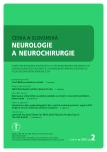Meningioma Diagnosis, Therapy and Follow-up at the Neurosurgery Clinic, University Hospital Brno between 2005 and 2010
Authors:
M. Duba; A. Mrlian; M. Smrčka; J. Musil
Authors‘ workplace:
Neurochirurgická klinika LF MU a FN Brno
Published in:
Cesk Slov Neurol N 2013; 76/109(2): 211-216
Category:
Short Communication
Overview
Introduction:
Meningiomas are usually slow-growing tumors that arise from meningothelial cells and represent about one third of all primary intracranial tumors. They predominate in women. A patient may have multiple meningiomas. Clinical manifestations of meningiomas are determined by location and tumor size. Treatment is mostly surgical; success rate depends on the extent of resection. Radiotherapy is another treatment modality used, whilst hormonal therapy remains on experimental field.
Material and methods:
Authors describe their experience with the diagnosis, treatment and follow up of patients with meningioma (n = 314). Furthermore, they also assess postoperative morbidity and time to recurrence.
Results and conclusion:
Despite mostly benign histology of meningiomas, their recurrence is relatively frequent and oscillates between 10 to 30%, always in association with the extent of resection. Therefore, these patients should be followed up and regularly monitored using magnetic resonance imaging.
Key words:
meningioma – diagnostics – treatment – follow-up
Sources
1. Wiemels J, Wrensch M, Claus EB. Epidemiology and etiology of meningioma. J Neurooncol 2010; 99(3): 307–314.
2. Kane AJ, Sughrue ME, Rutkowski MJ, Shangari G, Fang S, McDermott MW et al. Anatomic location is a risk factor for atypical and malignant meningiomas. Cancer 2011; 117(6): 1272–1278.
3. Larjavaara S, Haapasalo H, Sankila R, Helén P, Auvinen A. Is the incidence of meningiomas underestimated? A regional survey. Br J Cancer 2008; 99 : 182–184.
4. Claus EB, Bondy ML, Schildkraut JM, Wiemels JL, Wrensch M, Black PM. Epidemiology of intracranial meningioma. Neurosurgery 2005; 57(6): 1088–1095.
5. Dumanski JP, Carlbom E, Collins VP, Nordenskjöld M. Deletion mapping of a locus on human chromosome 22 involved in the oncogenesis of meningioma. Proc Natl Acad Sci USA 1987; 84 : 9275–9279.
6. Seizinger BR, de la Monte S, Atkins L, Gusella JF, Martuza RL. Molecular genetic approach to human meningioma: loss of genes on chromosome 22. Proc Natl Acad Sci U S A 1987; 84 : 5419–5423.
7. Koehorst SG, Jacobs HM, Thijssen JH, Blankenstein MA. Detection of an oestrogen receptor-like protein in human meningiomas by band shift assay using a synthetic oestrogen responsive element (ERE). Br J Cancer 1993; 68(2): 290–294.
8. Perrot-Applanat M, Groyer-Picard MT, Kujas M. Immunocytochemical study of progesterone receptor in human meningioma. Acta Neurochir (Wien) 1992; 115(1–2): 20–30.
9. Alexiou GA, Markoula S, Gogou P, Kyritsis AP. Genetic and molecular alterations in meningiomas. Clin Neurol Neurosurg 2011; 113(4): 261–267.
10. Sughrue ME, Kane AJ, Shangari G, Rutkowski MJ, McDermott MW, Berger MS, Parsa AT. The relevance of Simpson Grade I and II resection in modern neurosurgical treatment of World Health Organization Grade I meningiomas. J Neurosurg 2010; 113(5): 1029–1035.
11. Palma L, Celli P, Franco C, Cervoni L, Cantore G. Long-term prognosis for atypical and malignant meningiomas: a study of 71 surgical cases. Neurosurg Focus 1997; 2(4).
12. Kollová A, Liščák R, Šemnická J, Šimonová G, Vladyka V, Urgošík D. Dlhodobé výsledky liečby meningeómov Leksellovým gama nožom. Cesk Slov Neurol N 2010; 73/106(4): 415–421.
13. Pannullo SC, Fraser JF, Moliterno J, Cobb W, Stieg PE. Stereotactic radiosurgery: a meta-analysis of current therapeutic applications in neuro-oncologic disease. J Neurooncol 2011; 103(1): 1–17.
14. Pollock BE, Stafford SL, Utter A, Giannini C, Schreiner SA. Stereotactic radiosurgery provides equivalent tumor control to Simpson Grade 1 resection for patients with small - to medium-size meningiomas. Int J Radiat Oncol Biol Phys 2003; 55(4):1000–1005.
15. Náhlovský J et al. Neurochirurgie. 1st ed. Praha: Galén 2006.
16. Kozler P et al. Intrakraniální nádory. 1st ed. Praha: Galén 2007.
17. Palma L, Celli P, Franco C, Cervoni L, Cantore G. Long-term prognosis for atypical and malignant meningiomas: a study of 71 surgical cases. J Neurosurg 1997; 86 : 793–800.
18. Younis GA, Sawaya R, DeMonte F, Hess KR, Albrecht S, Bruner JM. Aggressive meningeal tumors: review of a series. J Neurosurg 1995; 82 : 17–27.
19. Bendszus M, Rao G, Burger R, Schaller C, Scheinemann K, Warmuth-Metz M et al. Is there a benefit of preoperative meningioma embolization? Neurosurgery 2000; 47(6): 1306–1311.
20. Schul DB, Wolf S, Krammer MJ, Landscheidt JF, Tomasino A, Lumenta CB. Meningioma surgery in the elderly: Outcome and validation of two proposed grading scores systems. Neurosurgery 2012; 70(3): 555–565.
Labels
Paediatric neurology Neurosurgery NeurologyArticle was published in
Czech and Slovak Neurology and Neurosurgery

2013 Issue 2
Most read in this issue
- Creutzfeldt-Jacob disease
- Spinocerebellar Ataxia 7 – a Case Report
- Lyme Borreliosis as a Cause of Bilateral Neuroretinitis with Pronounced Unilateral Stellate Maculopathy in a 8-Year Old Girl
- Electrophysiological Examination of the Pelvic Floor
